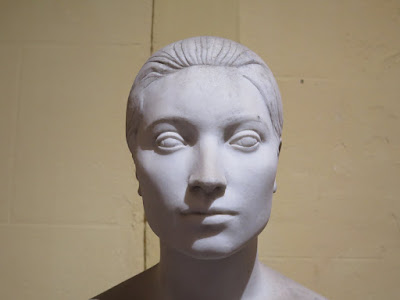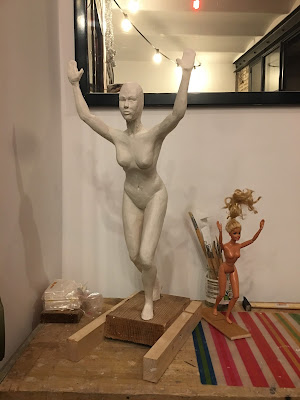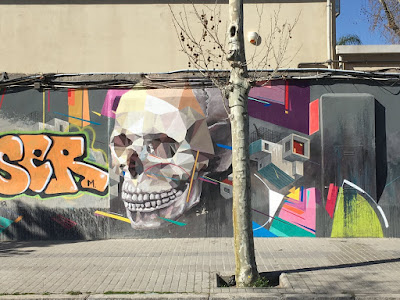As anyone reading this blog has probably noticed, I am having a burgeoning interest in classical figurative sculpture while here in Barcelona. (I had a moment once, while perusing the Art section of the Strand Bookstore in NYC many years ago, in which I suddenly realized the pervasiveness and durability of the human body as subject in the history of art. It was a liberating moment; it was the first time I allowed myself to identify the human body as an artistic interest of my own. Plus, I never went to art school or really even studied much art, so I've never done the "classical figurative" thing before.) Barcelona is certainly a place that is conducive to fostering this interest. The city itself is full of beautiful figurative sculpture in bronze and marble, and there are a few museums which focus on this type of work. One such museum, the Frederic Mares Museum, has already been discussed here.
Not long ago I became aware of another museum called the MEAM (or Museu Europeu d'Art Modern [that's Catalan]), which is a museum focusing on figurative art in both 2D and 3D from the twentieth and twenty-first centuries. I visited the museum a few months ago and was pleasantly surprised (although perhaps not "blown away") by a good selection of modern, mostly nude sculpture.
Then, about a month ago, I happened to see an announcement on one of the video screens in the Metro which was advertising a retrospective of a sculptor called Josep Salvadó Jassans, at the MEAM. From the brief clip on the monitor, I could tell I would be interested in his work, so I went back. Well, I was sort of blown away by Jassans.
This piece is called Gerda, in black marble.
I've spent some time trying to decode why I like his work so much, and it hasn't been perfectly easy to figure out. More on this later, but I can certainly start by pointing out that the guy was technically a master. There's nothing out-of-place here, no proportion that is wrong.
This bronze is called Grella, and is one of my favorites.
This is Portrait of Antonieta Borrás, Jassans' wife, carved in wood.
These first three pictures start to give an idea of what I was able to identify as one reason I like Jassans... which is that in my opinion his work shows a very slight idealization... I have come to think of it as "110% of reality."
It is essentially impossible to find any writing of substance on the topic of Jassans in English - 80% seems to be in Catalan with the balance being in Spanish. So, my understanding of his philosophy of sculpture is rudimentary. But I do know that he had an idea that sculpture could be more than just a copy of reality and could in fact be what he called "plastic reality." (In light of the facts that these days we can scan and print a person in 3D, and that there has been SO MUCH excellent sculptural copying of reality through the centuries, one might even advance the argument that sculptural copying of reality is no longer necessary. I am reminded of the way that painting was radically transformed by the advent of photography. Suddenly liberated from the obligation to accurately document reality, painting became looser and freer - it became something else entirely.)
What exactly Jassans meant by "plastic reality" is something I don't entirely understand, but I believe that it involved seeing a perfected version of reality and capturing it materially. In any case, this 110% of reality strongly appeals to me. It is as if Jassans acknowledged the impulse to depict regular people as super-heroes, or as their better and more physically perfect selves, but restrained the impulse just the right amount, never veering off into anything that might be perceived as unreal or unnatural.
(Please note: these are just my personal thoughts; I'm sure there are many who have written much more, and much more accurately, on Jassans... in Catalan!)
Here we have two more images which begin to reveal even more that I like about Jassans. In the first image we see Jesus on the cross, and in the second a sketch he did for a proposed sculpture of Barcelona's co-patron saint, Santa Eulalia. (Had it been accepted, this proposal would have led to a prominently placed sculpture at Gaudi's Sagrada Familia church. Despite its faithfulness to Eulalia's alleged treatment at the hands of authorities, it was rejected and never sculpted, perhaps (?) because of its eroticism).
It turns out that Jassans was a religious man, a believer, (which is usually the kiss of death for me, but in this case just adds to the intrigue) and as such these two pieces are almost certainly not depicted in erotically charged ways for reasons of iconoclasm for its own sake, although they do appeal to me largely because of my own love of iconoclasm. Jassan's motivations must have been something else. I can't read enough Catalan to faithfully re-present here his actual position, but I can get hints from some of the short English translations presented at the MEAM. He believed that the human figure, especially the female, was nature's (or God's?) most perfect creation, the embodiment of beauty. And so why, then, would there be any reason to depict it in any way other than it's natural state? His work seems to me to be a simple, almost naive glorification of what God gave us.
And, the effect of this approach veers unavoidably close to eroticism. Here we come to yet another reason I like his work so much... it appears to ride an extremely fine line between naive and erotic. It's as if it is erotic, without meaning to be. Erotic simply because the human body is worthy of depiction, and the human body is beautiful. There is nothing that screams "cheesy" or "low" more than a piece of art made in the service of eroticism for it's own sake... yet, where is the line? Why does some work make us sigh and roll our eyes, while other work makes us simply amazed at the perfection of humanity?
Well, anyway, all this sudden interest in Jassans got me searching around the internet for more info about him, and I noticed an upcoming lecture. It turns out that we are now at the 10-year anniversary of his death, which is why there is currently a spike in interest and exhibitions. I attended the lecture, given by the ICRE (Catalan Institute for Research in Sculpture) and met the two men responsible for not only ICRE but also for the exhibition at the MEAM, Adrian Arnau and Jorge Egea. The lecture was in Catalan so I ended up spacing out quite a lot, although when I really tried I seemed to be able to understand about 20% of it.
A bit more searching on the web revealed that, although Barcelona is without even a single example of Jassans' work, a nearby town called Reus is liberally endowed. Following the thread, I loaded my bicycle onto a train and headed two hours to Reus to give myself a self-guided tour. I had stayed in touch with Jorge and Adrian, the fellows from ICRE, and they provided me with a map to get me to all the sculptures scattered throughout Reus.
This one is called La Flama, or The Flame. Its significantly larger than life, and positioned in front of a psychiatric hospital. The building itself is also famous for its architecture. Clearly we have an example here of the female nude being articulated in a specific pose intended to convey the uplifting potential of the human spirit, or something along those lines.
This small sculptural group is called La Pastoreta. It forms a sort of dialogue within the city with another sculpture of the same name and theme, the other done by Jassans' master, Joan Rebull. Although Rebull's has a more prominent place in the city, I think Jassans' take on this theme is so much better.
Cant a la Vida, or Song of Life. This is at a hospital in Reus. At this point, there is a minor theme emerging in Jassans' public works in Reus of female figures with their arms up. Again, possible themes seem to include lofty things like "the glory of man," "the human spirit," "the perfection of human life," stuff like that.
This piece is simply called Wind. Again, arms up. This is situated in the old part of town on a pedestrian walkway.
And now, for my very favorite of Jassans' sculptures. This one is called La Republica, and is a tribute to Lluis Companys, an important figure in the history of Cataluña who was executed at Montjuic castle here in Barcelona by Franco in 1940.
Again, arms up, a triumphant figure, a beautiful female nude (or near-nude). Christina asked me why a female nude would be used as a tribute to someone like Companys, and given such a lofty name as La Republica. I must admit that I do not really know the answer, but my thoughts are this: Jassans may have felt that nothing is more perfect than the human female form, and as such nothing is better suited to sculpturally expressing ideas or feelings. If you want to sculpturally express something like "the glory of Cataluña," let's say, just do it with a triumphant and glorious female figure, arms up. If you want to sculpturally express something like "the power of wind," or perhaps "the power of nature," for instance, do it with a female figure being bent by the wind. The same holds true for Cant a la Vida (the glory of life / birth), La Pastoreta (the bounty of the land), and La Flama (the eternal flame of the human spirit to overcome adversity [mental illness??] through striving upward... or something like that). And why not? Why not choose the female form, the pinnacle of God's, or evolution's, work as a vehicle for these forces, thoughts, and ideas? Is it not more original, interesting and thought-provoking to show a woman bent by wind rather than a tree? (Again, please note that these are just my thoughts, and not scholarly or researched opinions... remember, me no Catalan.)
For reasons that I cannot really explain and which must be subconscious / psychological in nature, I have a long and abiding interest in sculptures of women with their arms triumphantly raised. Many years ago I did such a sculpture (of which I unfortunately do not have a picture to post here), and I recently began another such sculpture here in Barcelona.
Strangely enough, when I started this sculpture I said to myself "I must not make this one look just like that other one I did several years ago," but I am pretty sure I have inadvertently done exactly that. How's that for psychology? As you can see, this sculpture still has a way to go.
Although I can't explain the source of my interest in the triumphant, arms-up posture, that very interest of mine does at least explain my love of La Republica.
OK, so when I got back from Reus I was quite keen to try to get more serious about sculpting on my own. I was in the middle of looking into various classes at various art schools around town (all far away from the Raval), trying to decide which of the (too expensive in my opinion) classes to take, when I wrote an email to Adrian and Jorge, the guys from ICRE, telling them about my adventure in Reus. I off-handedly asked if I could see their sculpting studios, and to my surprise Jorge wrote back quite quickly and said I could come by that day, after lunch. And, his studio is right here in the Raval. So, not expecting anything in particular, I headed over there.
Well, it turned out that Jorge
• Is a really nice guy
• Is a super talented and famous sculptor
• Gives very reasonably priced classes in his Raval studio, and
• Was a student of Jassans!
There was even a Jassans piece sitting in Jorge's studio. He explained to me that it is there for repairs of various damages done to it by its careless rich owners (you can see that the arm at left was actually completely broken off! And there are other smaller damages which are harder to see)
I was excited about Jorge's close association with Jassans, and asked a few questions. Although we didn't talk that much, I learned that Jassans had no interest whatsoever in becoming famous, which might partially account for his relative obscurity. And, he apparently talked a lot about the perfection of river stones, and about ways in which the body might be depicted more like a river stone. Jorge pointed out to me that Jassans almost never sculpted wrinkles, or even fingernails. Not too far off from my 110% / super-hero theory. I hope to learn more about Jassans as I spend more time with Jorge.
Yesterday I took my first class with him, my first day ever in my life sculpting from a live model. It was fun, and frustrating. I want to be "a natural," immediately good, but I'm not, really. But I think I'm not bad, either. Classes are 7 hours long, every Thursday. Sometime soon, when my sculpture looks a bit better, I will post a pic.
Every August Jorge organizes a trip to Carrara, Italy, for a marble sculpting workshop. Boy oh boy do I want to do that! Will update.
Well if you got this far, thanks for hanging in there with me through this long post. I'm pretty sure the next few posts won't be this epic.
Goodnight, from Barcelona.









































